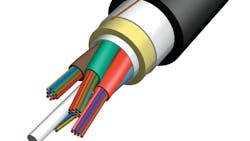AFL adds Flex-Span configuration option to ADSS cable family
AFL has added a new Flex-Scan option to its single-jacket All-Dielectric Self-Supporting (ADSS) portfolio. As Flex-Span designs are optimized for a wider combination of fiber counts and span lengths, ADSS system designers now have more flexibility, the company asserts.
The new Flex-Span option’s core configuration supports five buffer tubes of 24 fibers each for a total of 120 fibers. The configuration enables higher fiber counts in a diameter of less than 0.475 inches without compromising span length, AFL says. Use of smaller diameter fiber-optic cable can lessen pole loads without affecting hardware size.
Flex-Span ADSS cables, including those based on the new configuration option, don not need support or messenger wire, which AFL says enables installation in a single pass. The company says the fiber cable is suitable for distribution lines and necessitates the use of formed wire dead ends. Flex-Span also uses dry core technology, which obviates the need for flooding compounds.
Overall, Flex-Span ADSS cables come in fiber counts from 12 to 144, in any type or combination of single-mode or multimode fibers, AFL says. Operating temperatures run from 40˚C to +70˚C and pole-to-pole span lengths can range from 50 feet (15 meters) to more than 1,000 feet (305 m).
For related articles, visit the FTTx Topic Center.
For more information on fiber cable and suppliers, visit the Lightwave Buyer’s Guide.

Stephen Hardy | Editorial Director and Associate Publisher, Lightwave
Stephen Hardy is editorial director and associate publisher of Lightwave and Broadband Technology Report, part of the Lighting & Technology Group at Endeavor Business Media. Stephen is responsible for establishing and executing editorial strategy across the both brands’ websites, email newsletters, events, and other information products. He has covered the fiber-optics space for more than 20 years, and communications and technology for more than 35 years. During his tenure, Lightwave has received awards from Folio: and the American Society of Business Press Editors (ASBPE) for editorial excellence. Prior to joining Lightwave in 1997, Stephen worked for Telecommunications magazine and the Journal of Electronic Defense.
Stephen has moderated panels at numerous events, including the Optica Executive Forum, ECOC, and SCTE Cable-Tec Expo. He also is program director for the Lightwave Innovation Reviews and the Diamond Technology Reviews.
He has written numerous articles in all aspects of optical communications and fiber-optic networks, including fiber to the home (FTTH), PON, optical components, DWDM, fiber cables, packet optical transport, optical transceivers, lasers, fiber optic testing, and more.
You can connect with Stephen on LinkedIn as well as Twitter.
